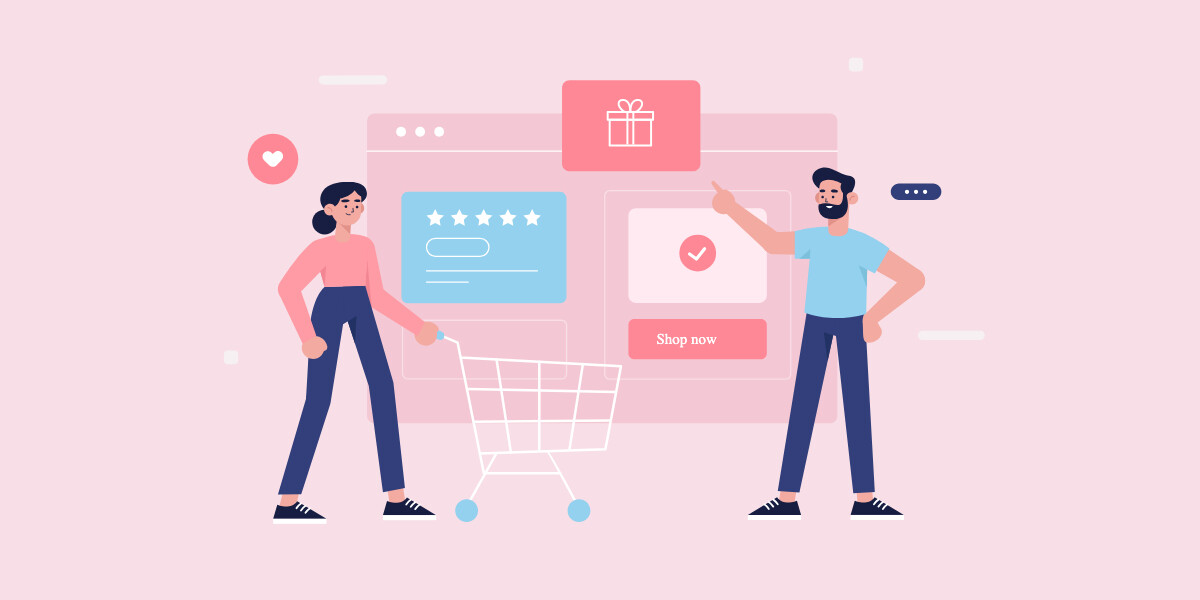
The AI of Personalized Ecommerce Product Recommendations
Product recommendations have been around since the first magazines were ever sold as a personalized marketing tactic. From suggestions of ingredients to use for a recipe to the famous “Complete the look” items, you’d get in fashion magazines.
These old methods though just weren’t smart and instead provided clearly subjective suggestions. A smart and accurate recommendation system for e-commerce is always AI-driven.
Simply put, e-commerce websites now use a shopper’s past behavior to give recommendations for products they might like. Kind of like you might already be using a web user’s preferences to send targeted ads or emails.
Despite knowing how strong the power of personalization is, marketers are still not doing it correctly, sending all the wrong product recommendations. According to a survey by Bazaarvoice, only 25% of users have seen personalized home pages on the websites and stores they checked out and fewer than 20% can say these were very relevant to their needs. However, as many as 63% of people would want to get these exclusive offers that are tailored to their own preferences.
So let’s take a full look at how you can make informed personalized recommendations for e-commerce with the help of AI. We’ll go into everything you need to know to make these recommendation engines work for your e-commerce business.
How does AI fit into the e-commerce product recommendations process?
While terms like artificial intelligence, machine learning, data mining, or neural networks for building a recommender system all sound ultra-complicated, the idea behind them is simple:
You’ve got a series of intelligent calculations and algorithms that gradually learn a customer’s behavior and are able to predict what their preferences are.
Just like humans get to know someone and are then able to guess what the best birthday gift for them would be.
Only AI doesn’t really guess.
It uses a plethora of data like:
- search queries
- viewing history
- past purchases
- items placed in the shopping cart
- products you’ve recommended on social media
- location
- dwell time
- customer segments/buyer personas
Without an AI system in place, you’d probably just assume what people wanted to see.
But people’s tastes and preferences are naturally going to change over time. A smart system helps you keep up with constant alterations of their needs and other market trends. The latter result from people’s buying decisions as well.
The underlying principle between AI’s success in creating personalized product recommendations is that there are trillions of dependencies between users and items. There’s just too much data and relations among them for humans to accurately make recommendations without going through complete databases. This would take years and years and you’d never be able to keep up with the fast changes.
In the background everything looks like this with all data being interconnected:
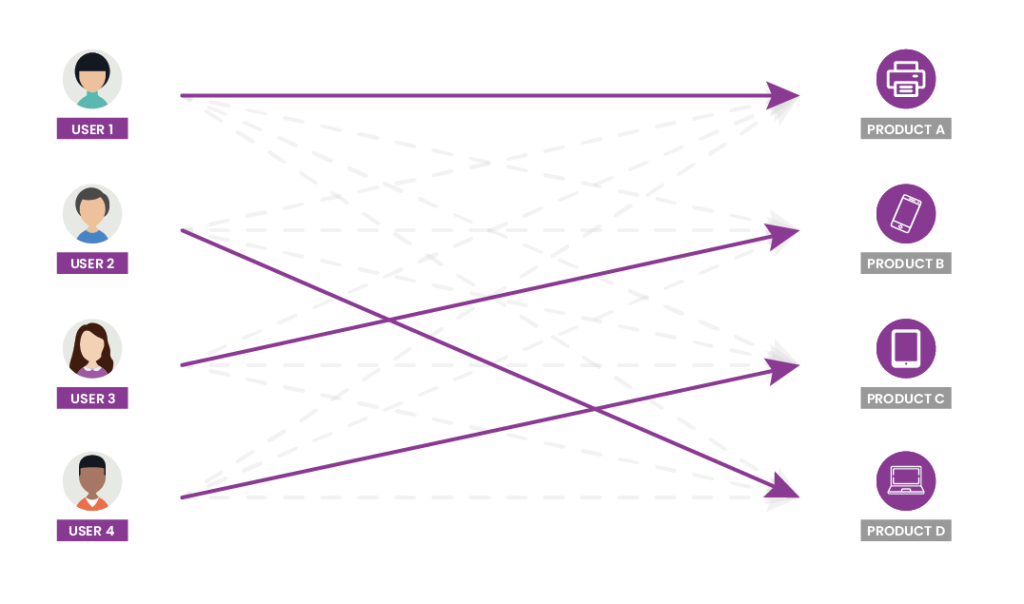
The algorithms of each product recommendation engine can tell whether one user or item is associated with another.
But what users are being displayed is the result of all these data and calculations. Predictive analytics might sound like science fiction or as if they’re out of your reach, but the truth is all top online stores and websites are using it.
Naturally, more choices require more options for filtering and, implicitly, more algorithms you can take advantage of to sort your data.
That’s exactly where AI-driven e-commerce product recommender systems come in to save the day.
The benefits of AI-based e-commerce product recommendations
Along with the general effects machine learning can have on your business goals:
- higher profits
- increased customer loyalty
- higher conversion rates and average order value
There are various main benefits you can experience once you roll out these personalized product recommendations for your online store:
Personalization
The primary purpose of AI-based e-commerce recommendation systems is to help you choose the right products to get in front of your shoppers. Everything is backed by real data on products they’ve previously liked or showed interest in so you’ll no longer have to guess what buyers might be looking for.
This will also allow you to send customized newsletters in the future so every subscriber will get different recommendations. And the entire process is automatized, of course.
Use data in real-time and across multiple channels for immediate results
The future of custom product recommendation systems will allow you to target new customer segments and be present everywhere. On social media, mobile apps, via email, and, of course, on your website.
Simultaneously, you’ll be able to promote your entire range of merchandise, including new items, and even record user behavior data as it happens. So if a niche product’s popularity suddenly soars overnight, you won’t have to wait until the next morning to update your recommendations because all this is done in real-time.
Automate your e-commerce marketing strategy
Record new data and customer reactions so you can reuse them for future campaigns.
Beyond this, we all know setting budgets is not the most exciting part of marketing. AI recommender systems allow marketing professionals to prioritize their spending according to how consumers will act. So you’re not putting your money where no one cares.
Enhance the customer experience and engagement
In a similar vein to automating your efforts, these digital systems allow you to constantly keep up with a user’s changing interests. As humans, we’re always looking to save time so we prefer to be shown what we like so we don’t have to do the search ourselves.
As a result, people are more likely to remember your brand and website if it once provided a good customer experience for them. This results in more loyal and recurrent buyers that can also recommend you to their peers.
Improve cart value
If you’ve been in the e-commerce business for a while now, you probably already have hundreds if not thousands of products on your shop. In fact, AI-driven methods for recommending products to customers work best when there’s more data to use.
Recommending the same things over and over again is clearly not going to improve the value of people’s carts since they’ve already seen those products, are not interested in them, or might not want to repurchase. Instead, you’re using your large database of products to always recommend new products that will appeal to their needs and wants.
This benefit, in particular, holds a higher value for e-commerce stores that offer free shipping. Your goal is to get a customer to buy as many things as possible once so you won’t have to pay several times for the shipping of the same number of items to one person.
Traditional vs. AI-driven product recommendation methods for e-commerce in practice
Years ago, when machine learning was minimal, websites and eShops would use manual recommendation systems.
Users and buyers recommended a product to their friend or create “recommendation” lists for must-use products, must-see movies, or just beauty items you need to try this year. IMDB and Pinterest lists are still popular these days.
Then you had your classic [still in use but not so dependable anymore due to their subjectivity] Top 10 or Best lists that were manually curated by a website’s owner, marketer, or writer.
Product recommendations today exist in various forms. Even choosing to display one item over another on your homepage is a form of recommending products to customers.
Showcasing popular items by number of sales
This non-personalized technique is not based on a user’s individual choices but rather on collective preference.
Recommendations are displayed based on criteria such as:
- The number of items purchased [like when a new iPhone model is released and everyone rushes to get it]
- How much time shoppers spent viewing that item [repeatedly placing an item in the cart or spending more time viewing a movie or video like for YouTube’s algorithm]
- Number of item views and purchases in your country or area
As a user enters a website, data is recorded in the background but since it might be their first time in that store, recommendations are very general, based on overall popularity.
Etsy is a perfect example of an e-commerce platform that uses popular items to display recommendations.
Cross-selling and upselling
Two other methods for recommending products that are commonly done manually are cross-selling and upselling. Both of these are aimed at helping people choose the best items possible while also increasing your revenue even if you’re selling to a new customer.
Cross-selling is a strategy for recommending products based on an item that a customer has decided on or already owns.
Everyone does cross-selling in one way or another from the dessert you’re recommended at a restaurant to the batteries you’ll need to get your new kitchen scale to work.
There are literally dozens of techniques to use for product recommendations with a cross-selling purpose like.
Special discounts for relevant accessories when buying a specific item like in the Crutchfield store:
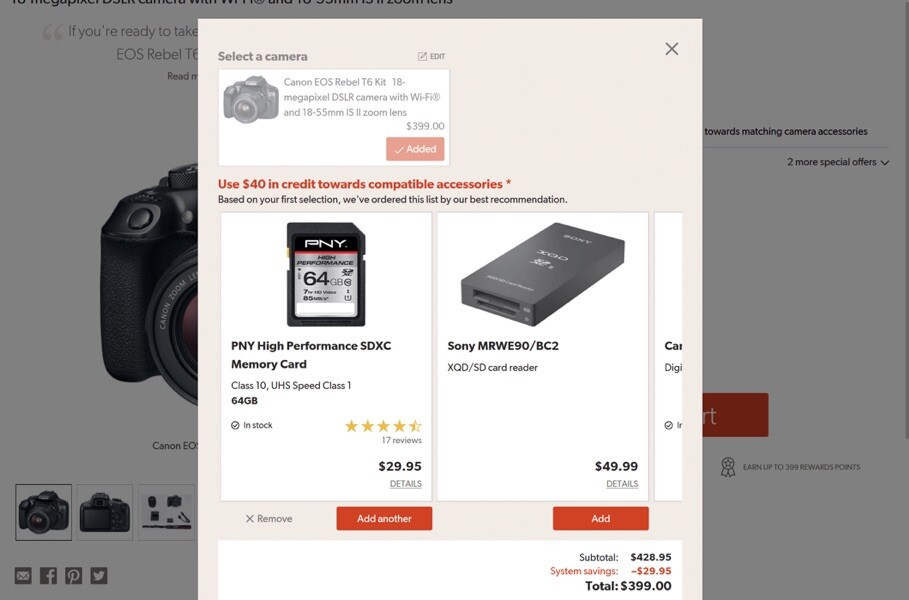
Not all product recommendations are focused on cross-selling.
The next step would be to upsell your online store’s items by getting people to also purchase products that are either:
- more expensive
- or just add on features for an extra cost to the initial choice
Apple has mastered this upselling technique, guiding shoppers to go for a larger model or more storage space at an additional cost:
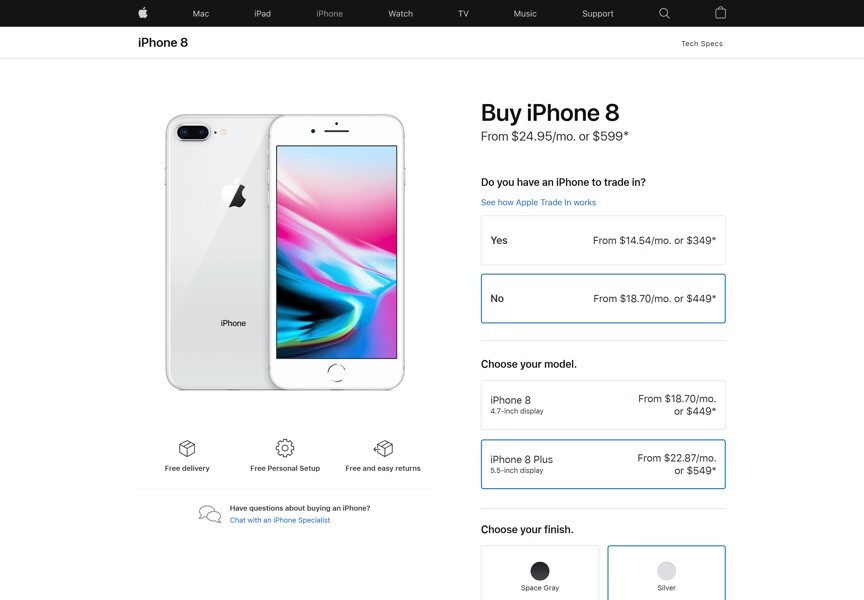
You’re getting the same phone but with added performance-boosting features that are easy to upsell through recommendations.
The most basic and common upselling method is based on size, getting people to opt for a large version of the product they want:
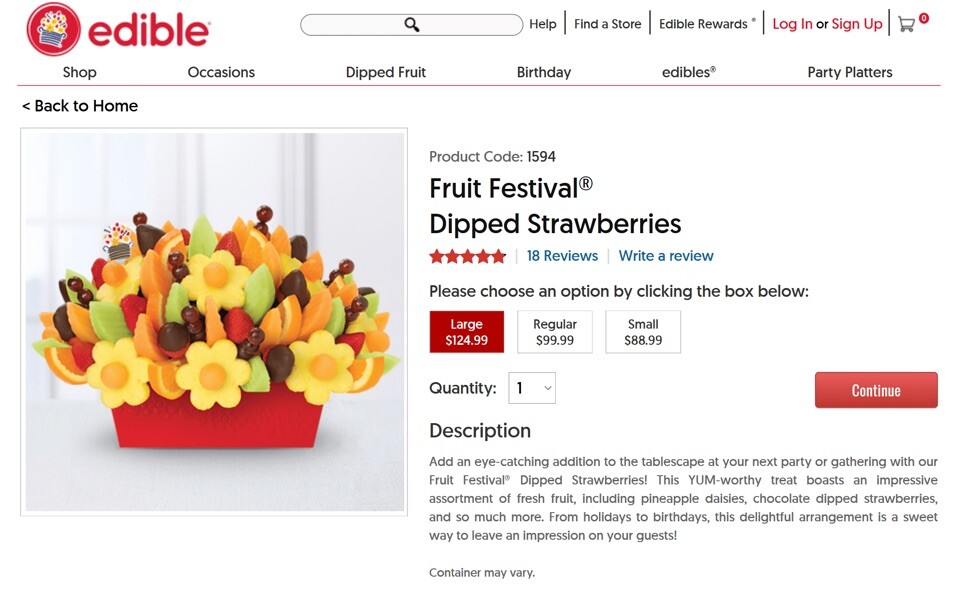
Location-based recommender systems
With this product recommendation system, customization is minimal as we only take the location of a user into account. 
You can go for this option if you don’t have or don’t collect other types of information.
The problem is that while this system is easy to implement, it doesn’t bring much value. Personalization choices are poor and there’s a high chance that everyone will get roughly the same recommendations, leaving your new products behind.
When going for this system, e-commerce marketers choose to display a disclaimer like “People around you also liked” or “People in your area also bought”. The target behind this method is that you’re trying to guess any potential social relations or particularities for people in one geographical area. If you sell merchandise worldwide, you might want to display products that are suited for a specific country’s unique holidays or current events in such sections.
One of the most common similar campaigns could be for “Back to school season”. The first day of school differs from one country to another. A parent from Australia where school starts around February 1 won’t be interested in seeing ads for office supplies and backpacks in August which is a common month for US schools to open.
Frankly though, there’s limited use for location-based recommendations when you’re selling at an international or nation-wide level. Instead, it’s a method you use via mobile to bring in people to your physical stores when they’re in town or passing by your store.
Content-based filtering techniques for ecommerce product recommendations
This method relies on the similarities between the items you’re selling: products, movies, songs, anything.
Each of these items has a series of characteristics or features that define them and every single pair of users is taken individually and compared with each other.
Let’s say you’re selling movies on one section of your online shop.
Then you have a customer who’s previously bought 10 movies from you. 8 out of those 10 films were animated or maybe they had the same director. What content-based filtering does is use a series of boolean data systems to judge what the best recommendation for that customer would be based on the features of past acquisition and movies they checked out or even added to their cart.
As a result in this case, the system is most likely going to recommend a bunch of animated movies from the same director or with the same themes.

It’s really your basic math brain teaser:
Jane likes apples and oranges. Mark likes oranges. So, there’s a high chance for Mark to like apples too.
The more features two items have in common, the higher the chance for them to be recommended.
The issue with content filtering alone is that you need to gather A LOT of data to give a perfect recommendation.
For a movie, you need to gather information on genre, secondary genres, length, actors and other film crew, year of release, language, etc. In fact, when Netflix started out they didn’t have any smart AI-based technique in place so they just asked their users to complete a long survey beforehand.
This preference data was clearly not accurate as it required people to manually select responses which they weren’t entirely sure of in the first place. Plus, describing how much you look one movie genre over another is fairly difficult anyway.
This recommendation technique for e-commerce is a good choice for stores that are just getting started and have a few purchases but no ratings. The e-commerce recommendation engine will be able to use another buyer’s past acquisitions or cart content to make suggestions to other users.
Airbnb also uses content-based filtering to recommend stays based on host preferences. ?
Mind-blowing? So simple in practice though.
Hosts have the right to accept or reject guests. If you’re an active Airbnb user, you might have noticed there’s a certain order in which you get the first results. This is based on the hosts’ past acceptance rates and criteria.
So with accommodations on the first page of your results there’s a higher chance that the host will accept your stay. Move on to pages 10 and below and there’s a likelihood that you won’t be able to stay there. Maybe you’ve been looking for hosts who accept pets before or you need a long stay.
In practice, the platform also takes into account your own preferences and correlates them with the possibility for the host to give you the OK.
Here’s what an Airbnb search for London stays looks like when you’re not logged in:

Once I log in, I’m first recommended Airbnb Plus stays [this is what I’ve been commonly looking at it] as well as apartments that all have a kitchen, washer, and WiFi [I’ve always marked these facilities as mandatory]:
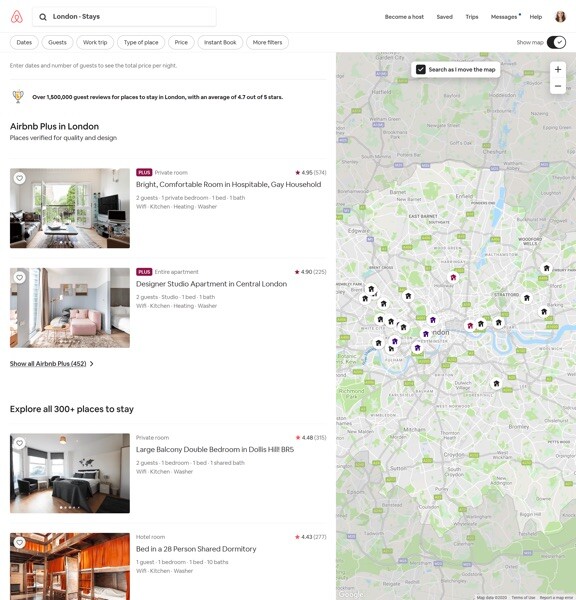
Entirely different results tailored to my preferences. Guaranteed to help people find the perfect stay faster and increase Airbnb’s conversion rates.
Wish you had this system for your store or what?
Here’s a detailed look at how their model works.
Collaborative filtering technique – User-User
The most popular of all product recommender methods, the collaborative filtering technique relies solely on how other customers and users have previously rated a product they purchased.
The method stems from the idea that people with similar past purchases and likings will probably want to use the same things in the future too. On top of this, it trusts real choices people have made as opposed to simple ratings which can be just an estimated guess.
Now there are two main ways in which you can do this:
- Use the classic star rating and ask people to leave a recommendation
- Have people choose between two or more products and the system will automatically rank one over the other in the backend
The process is simple but fairly lengthy.
Here’s how it all starts:
- User A rates a product with 4 stars.
- B rates the same product with 4 stars.
- User A then likes a product and gives 5 stars to it.
- B will be recommended the same product that user A has rated with 5 stars since it assumes that user B will also like it.
- …

As you can imagine this analysis continues for billions of queries for everyone in your database until complete profiles are created so the personalized recommendations are more and more accurate.
The good news is that with recommender systems, everything is done by the computer. Otherwise, you’d literally have to manually create profiles for each user.
While judging a product based on a real person’s reviews creates trust, the method lacks overall because users still need to take action in order to send in their ratings.
A better approach to this method [and why we’re so dependent on AI algorithms] is to take your large database and learn those ratings from their behavior.
If a person buys the same toothpaste regularly, the system can assume that a user has given it a high rating. On the other hand, if a product is returned or never bought again in favor of a competing option, that specific item gets a low rating.
Disclaimer
This method might not be the right fit for you if you’re just setting up your online store since you have none of this data to begin with.
Ratings-based recommendations
Have been around for a while and can be placed under the traditional methods list. They turn into collaborative filtering though once you’re starting to make customized recommendations based on users’ profiles and not just displaying a Top Rated list on your homepage.
Best Buy uses this type of basic online product recommendations based on general ratings:
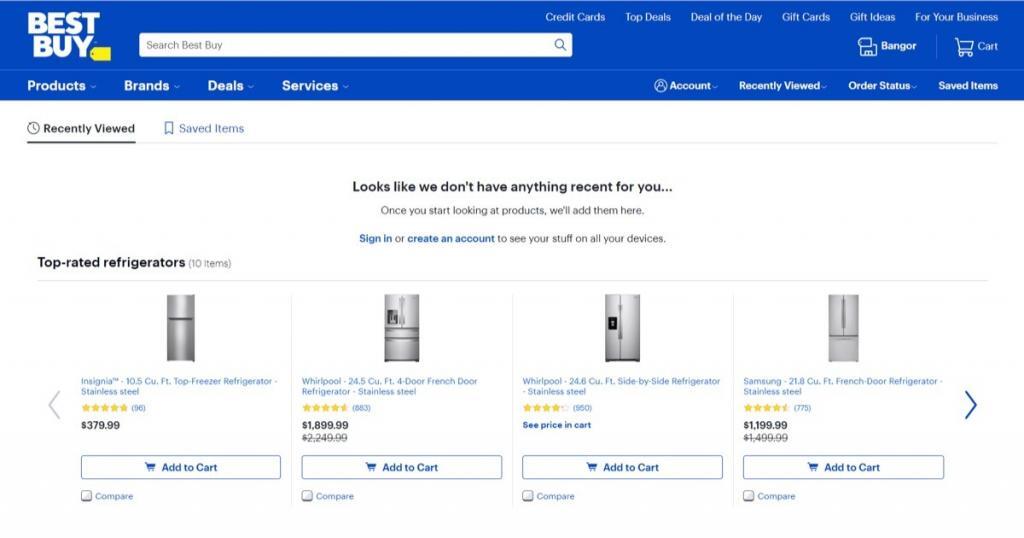
Collaborative Filtering Technique – Item-Item
The previous user-user collaborative filtering technique matched items based on different user’s purchases and behavior. With the item-to-item personalization method, products within a single user’s profile are interconnected without relying on other shoppers.
For instance, if you previously bought cookware from one brand, you’ll be recommended more cooking items from that same company.
Amazon is a perfect example for this technique:
“Amazon.com extensively uses recommendation algorithms to personalize its Web site to each customer’s interests. Because existing recommendation algorithms cannot scale to Amazon.com’s tens of millions of customers and products, we developed our own. Our algorithm, item-to-item collaborative filtering, scales to massive data sets and produces high-quality recommendations in real time.” – Greg Linden, Brent Smith, and Jeremy York
They also make use of bundle recommendations where products that are often bought together are recommended as a cross-selling tactic that’s based on buyers’ past purchase data. At least in theory, you can use an AI-based e-commerce product recommendation system to show real product choices users have made instead of handpicking them.
Remember how I said that smart personalized product recommendations could increase cart value?
Take this example of a product that’s been frequently placed in one cart with other similar products as they are recommended under the “Frequently bought together section”:
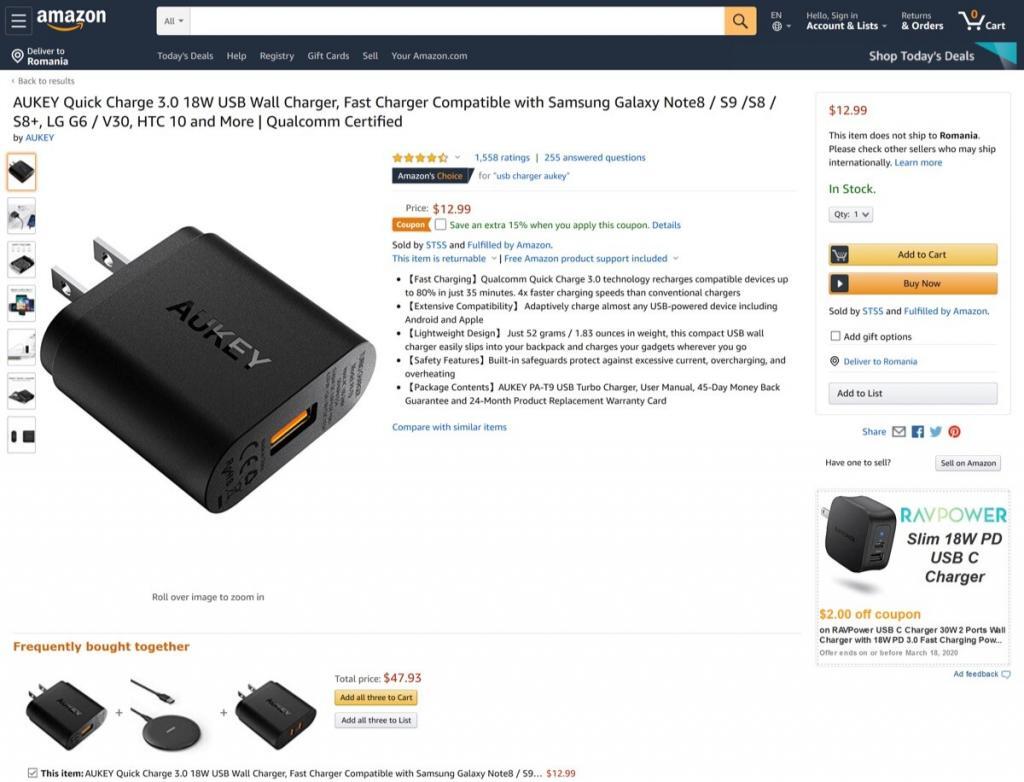
Hybrid ecommerce product recommendations
Most major websites use both the collaborative and content-based filtering techniques to guarantee the accuracy of the personalized recommendations. To tell you the truth, this is the norm and you can’t make it just by using one technique.
This is why you’ll never be recommended a horror movie if you’ve never even clicked on one even though another user with a similar profile as yours has given 5 stars to a horror flick.
If you’re still skeptical about the power of AI, just note that these hybrid recommendation systems have saved Netflix almost $1 billion every single year. And if you’re a Netflix user yourself, you have to admit you’re probably always watching what’s recommended to you.
The reason they pursued the hybrid system in the first place was that they realized what every e-commerce store owner should know:
Every single thing you put on your website is a recommendation by itself.
From what you choose to showcase on your homepage to the order of your categories and videos.
Simply using the ratings-based technique would be of no use for Netflix since multiple household members use the same account. As a result, their recommendations are intended for multiple people anyway.
Knowledge-based recommender systems
This recommender system draws relations between products and people’s needs starting with a set of predefined rules. Compared to the previous methods for recommending products, this method is better when used to push forward products that aren’t purchased on a regular basis. Like a new home, car, holiday destination, or expensive Rolex watch.
For luxury goods in particular, there just can’t be enough ratings.
When you’re buying something to use for 5+ years or even a lifetime, you rely on so much more than a rating.
In fact, many sellers who deal with these items don’t even display a rating since the brand will do the recommendation job. Also, preferences for these products can change radically. If you buy a new car every 10 years, there’s always considerably newer technology that needs to be taken into account.
Leaving all ratings aside, the knowledge-based recommender system uses queries [or searches if you want] to deduce what they’re looking for from a large data set. Hence the name. Knowledge bases are the database where you add in the specifications of every item you’re selling like horsepower for cars or the number of rooms for apartments.
When you look for a car on Cars.com, you can also opt to go for advanced filtering which essentially displays all elements of their knowledge base.
You mark your preferences and the algorithm calculates the best possible recommendations starting with the options that meet all of your criteria.
Think of it as advanced filtering that happens in a matter of seconds.
Final words on choosing the right personalized product recommendation system for your e-commerce website
To evaluate if one recommender system for e-commerce works as it should in your case, just do A/B testing [multivariate testing is also an option].
Start with a couple of predictions and a hypothesis like “This algorithm will improve engagement by X%”. Each alternative will be based on a separate recommender technique.
Disney have been using Google’s Recommendations AI to do A/B testing on their for thematic merchandise recommendations.
This solution helped them realize that showing relevant “More like this” products based on a person’s past shopping behavior and not just related to the products they’ve viewed improved their CTR, increased their revenue, and resulted in more “add to bag” actions. In return, this has also provided data for their “Frequently bought together” section to keep shoppers in the loop through cross-selling.
Here’s more on their experience and how they used one year’s worth of data to improve buyers’ experience:
Recommender engines like these are the reason you’re often seeing such precise recommendations on e-commerce stores.
Try to only test out the e-commerce product recommendation techniques with a higher chance of success 
This being said, testing the collaborative filtering technique against the content-based filtering techniques is simply a waste of time as most e-commerce stores are already using the hybrid technique since it’s proven to bring more accuracy.
Your developers will probably take care of the technical aspects but you still have one large role as the marketer: deciding which page to test the online product recommendations. This can be any location as long as you can gather enough data. Preferably go for sending out the test to only 20% of your traffic so you’re not breaking the recommendations for everyone in case something goes wrong.
If you want to test all of these personalized online product recommendation systems safely, without interfering with live data, you can have your data or web development team do tests in their sandbox [that is the test stage, before anything is live and available for everyone publicly].
With both cases, pay attention to your KPIs and how an individual technique affects them.
Your click-through and conversion rates for every single item and not just at a store-wide level are two safe choices you can start with if you haven’t done A/B testing before.
Ecommerce companies worldwide are already using personalized product recommendations to retain their customers and increase profits. If you took the time to go through the whole guide above, you’re probably aware of AI’s potential by now.
Your next step is to put together a plan for switching from any traditional methods you might be using to the AI-driven ones to dig deeper into customers’ interests and offer better product recommendations.